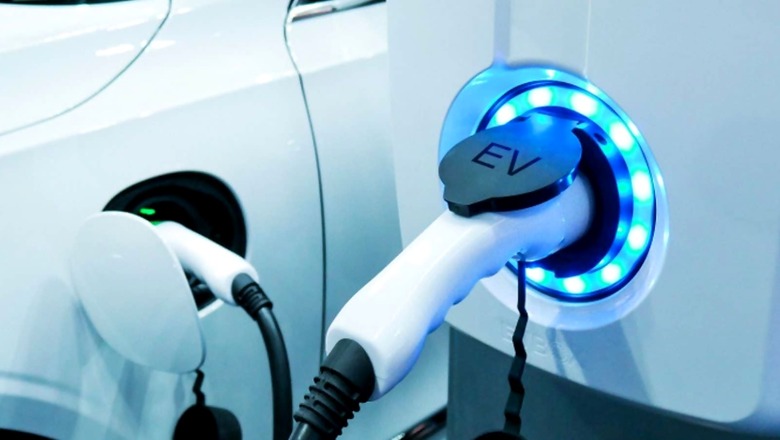
views
The first draft of the NITI Aayog’s ‘Battery Swapping Policy’ displays the Indian government’s commitment to building a conducive environment for the mass adoption of electric vehicles (EVs) in India. The policy discerns some of the prevalent issues affecting consumers currently dabbling in the EV market and aims to tackle these through technologically-intensive solutions. However, there is a significant lack of clarity about the potential business models that may arise if the battery swapping policy were to be implemented. As a result, India must look outwards to understand how potential stakeholders can be engaged to form a robust EV ecosystem in India.
In its first draft, the battery swapping policy has multiple advantages from a consumer point of view – through the establishment of the Battery as a Service (BaaS) model, Battery Charging Stations (BCS) and Battery Swapping Stations (BSS), EVs become highly accessible products in the market due to lower acquisition costs, time-efficient recharging options and the availability of reliable networks. The interoperability standards proposed by the policy will allow consumers the freedom of choice to purchase any EV without limitations on the availability of swappable batteries at a station. The assigning of a Unique Identification Number (UIN) at the manufacturing stage for tracking and monitoring EV batteries will alleviate concerns arising from the multiple incidents of flames in electric two-wheelers. By proposing to set up interoperability standards, battery management systems through UIN, and the engagement of multiple stakeholders within the EV ecosystem, India is offering a pragmatic alternative to the world’s reliance on high greenhouse gas (GHG) intensive sectors such as transport and energy. The next step in the process would be to assess the factors hampering the successful implementation of a battery swapping ecosystem in countries which have made this transition, and imagining what India can do differently to tap into the global market.
In this case, displaying a proof-of-concept in the domestic market would prove to be a crucial factor as nations worldwide are seeking technological solutions at a rapid pace to meet their commitments toward net-zero emissions. India’s battery swapping policy is currently at a nascent stage, mainly addressing the electric two and three-wheelers, but China has made giant strides in the sector.
According to a report by the International Council on Clean Transportation (ICCT), the State Council of the People’s Republic of China had released the New Energy Vehicle Industrial Development Plan for 2021 to 2035 in October 2020, in which they emphasised forming a globally competitive auto-industry with advanced New Energy Vehicle (NEV) technologies. This was complemented by a mid-term and long-term focus on building efficient battery swapping services and networks, recognising the fact that it could provide China with a competitive advantage in a sector that is gaining strategic importance due to growing environmental concerns. Based on a report in IDTechEx, China’s EV startup Nio has the most extensive network as of March 2022 with more than 800 battery-swapping stations offering customers a chargeable, swappable, and upgradable power plan. The report claims that there are more than 90,000 private passenger cars and around 25,000 taxis, which are swap enabled, with China’s indigenous companies such as Geely’s Soland Technology and State Power Investment Corp. testing battery swaps for trucks.
For India, the key to building a robust EV ecosystem through battery swapping networks would require successful implementation of the interoperability standards proposed in the policy – an aspect that China has struggled to impose in their market. According to a report in The China Daily, “there isn’t a uniform standard for the battery models and packs of different car brands, and automakers have different battery technologies and standards that are not unified at present”, hence limiting the practical application of battery swapping. This proves to be a major challenge as manufacturers prefer to hold their battery pack designs as intellectual property, signalling a disinclination towards cooperation on this front. A positive sign for India has been the interest in the Indian market from Japanese automobile manufacturers Terra Motors and Honda, both of whom have struck partnerships with local manufacturers even after a clear indication that there will be no backing down from the interoperability clause that has been proposed in the battery swapping policy. The onus would be on the Indian government to build on this interest, and pitch the sheer size of the market they would potentially be operating in as an incentive.
Another area through which India can establish a stronger EV ecosystem would be through establishing technological cooperation in verticals where standardisation is not a major concern for manufacturers. China’s reliance on indigenous manufacturers in the initial years also witnessed multiple cases of fire incidents in locally-built electric cars, forcing them to outsource battery design and manufacturing talent from Germany, South Korea and Japan.
Similarly, building technology for functions such as the integration of UIN with IoT-based battery monitoring capabilities, and battery recycling will depend on developing reliable external collaborations. In these domains, India must explore possible strategic partnerships through avenues like the QUAD, and fast-track the development of necessary technology for smoother implementation of the battery swapping policy. At a macro level, the recent Indo-Pacific Economic Framework (IPEF) is another avenue through which India can leverage its trade partnerships to create an impact in this sector, as clean energy, decarbonisation and infrastructure are one of the pillars on which this alliance has been initiated.
Hence from a strategic standpoint, it would help India to further define the business models and networks it aims to establish for the development of the EV sector through the battery swapping policy. Using China’s EV ecosystem as a prime example, India must contemplate how external collaborations can be leveraged in areas where there is low domestic competency. As of now, other countries in the Indo-Pacific region are establishing their footprints in this sector domestically, but since India needs to cater to a much larger population internally, it can use this scale factor to its advantage in attracting investors worldwide. Efforts to reduce ambiguity around how stakeholders will be placed in the domestic EV ecosystem, placing limits on self-reliant production and promoting international collaborations through loosening standards where necessary would be the preferred way forward.
Rohan Pai is an Assistant Programme Manager at The Takshashila Institution. The views expressed in this article are those of the author and do not represent the stand of this publication.
Read all the Latest News , Breaking News , watch Top Videos and Live TV here.
















Comments
0 comment